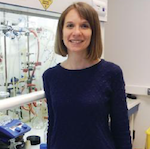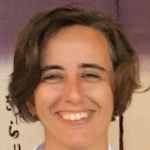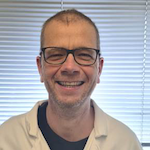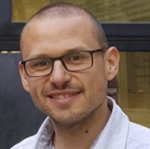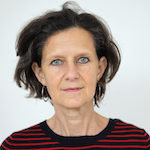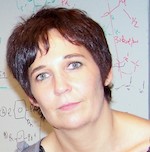
Speakers
Maryline BEYLERMaryline Beyler obtained a PhD in chemistry in 2010 from the University of Strasbourg. Her thesis consisted in the synthesis of porphyrinic catenanes assembled by coordination bonds and was supervised by Pr. Valérie Heitz and Dr Jean-Pierre Sauvage. Then, she joined the group of Pr Leif Hammarström (Fotomol group, Univ. of Uppsala, Sweden) as a post-doctoral fellow and worked with Pr Sasha Ott on pentacoordinate iron complexes as functional models of the [FeFe] hydrogenases. In 2011, she started a new post-doctoral position with Dr Richard Decréau (ICMUB, Univ. of Burgundy) where she synthesized phthalocyanine derivatives as imaging and therapeutic probes before to be hired in 2012 as associate professor at the University of Brest. She joined the research group of Pr Raphaël Tripier where she is mainly interested in the synthesis and functionalization of polyazamacrocycles and the study of their coordination properties for innovative diagnostic and therapeutic technics. Polyazamacrocycles • organic synthesis • coordination chemistry • cancer diagnostic and therapy |
|
Paola CERONIPaola Ceroni (born 1971) is a full professor in inorganic chemistry at the Department of Chemistry “Giacomo Ciamician” (University of Bologna) in Italy. She achieved her PhD in Chemical Sciences at the University of Bologna in 1998, working under the supervision of Prof. Sergio Roffia and Prof. Francesco Paolucci in the field of electrochemistry and spectroelectrochemistry of molecular and supramolecular systems. She obtained research fellowships at CNR (Institute of Photochemistry and High Energy Radiation, Bologna) and in the Photochemistry and Supramolecular Chemistry group directed by Prof. Vincenzo Balzani. She was visiting scientist in the laboratory of Prof. Allen J. Bard at the University of Texas at Austin (USA) in 1997 and, more recently, at UPenn (Philadelphia, US) in the laboratory of Prof. Sergei Vinogradov. She is author of more than 200 scientific articles in international journals, reviews and book chapters and several books on her specialist subject photochemistry. Her research activity are placed in the field of photochemistry of supramolecular systems and photoactive nanocrystals for imaging and energy conversion (luminescent solar concentrators, artificial photosynthesis and photocatalysis). She is the coordinator of a H2020 project on artificial photosynthesis (CONDOR) and she was the principal investigator of an ERC Starting Grant (PhotoSi) and an ERC Proof of Concept (SiNBioSys) for the development of luminescent silicon nanocrystals for solar energy conversion and bioimaging. Photoactive metal complexes • Photochemistry • Luminescent quantum dot • Aggregation induced emission • Supramolecular chemistry |
|
Peter FALLERPeter Faller is Professor in Chemistry at the University of Strasbourg (France) and Group Leader at the Institute of Chemistry. He studied at the University of Zürich (Switzerland) earning a PhD in biochemistry on metallothioneins in 1998 with Prof. M. Vasak. He did his postdoctoral studies on photosystem II at the CEA near Paris (France) with Dr. Bill Rutherford and in Freiburg (Germany) with Dr. Anja Krieger-Liszkay. In 2003 he was appointed professor and group leader at the LCC (Coordination Chemistry Laboratory of the CNRS) in Toulouse (France), where he stayed more than a decade, mainly working in bioinorganics on the role of essential d-block metal ions in the aggregation and toxicity of the peptide amyloid-beta linked to Alzheimer’s disease. In 2015 he moved to the Chemistry Institute at the University Strasbourg. Ongoing research projects of his group are in bioinorganics, still partly on the interactions of amyloidogenic peptides with metal ions, metalloproteins/peptides, but also on the development of copper(II) sensors for detection in a biological medium, mechanistic studies of chelators complexed with copper, zinc or iron in their anticancer and antimicrobial activity, and the development of hybrids of antimicrobial peptides and metal-complexes. Bioinorganic chemistry • Copper • Metallopeptides/proteins • Inorganic metal-based drugs • Reactive oxygen species |
|
Sébastien GOEBSebastien Goeb obtained his PhD degree in Organic Chemistry in 2006 under the supervision of Drs Raymond Ziessel and Antoinette De Nicola. He then carried out two successive one year postdoctoral stays respectively with Prof. Felix N. Castellano at the University of Bowling Green (USA) and with Dr Jean-Luc Parrain at the Institut des Sciences Moléculaires de Marseille (France). He became Chargé de Recherche CNRS in the laboratory MOLTECH-Anjou in 2008. His research activity focuses on the design of molecular architectures built by coordination self-assembly. In particular, he designs redox-stimulable molecular hosts capable of modulating their complexation properties, and is also interested in controlling the interlocking of molecular cages. Supramolecular chemistry • Coordination-driven self-assembly • Molecular hosts • Electro-actives compounds • Interlocked systems |
|
Corinne MATHONIÈRECorine Mathonière, born in 1968 in Montluçon (France), received her education in Chemistry at the University of Paris XI, France. Her Ph.D. work was devoted to the optical properties of molecular-based magnetic materials under the supervision of Prof. O. Kahn (in 1993). After a post-doctoral stay in the group of Prof. P. Day (Royal Institution of Great Britain, Londres), she joined in 1994 the University of Bordeaux 1 as associate professor, then in 2010 was promoted professor. In 2010, she got a junior position of 5 years at the Institut Universitaire de France. Since 1994, Dr. C. Mathonière has developed at the Institut de Chimie de la Matière Condensée de Bordeaux (CNRS) research activities in “Switchable Molecules and Materials” group interested in the synthesis and physical studies of switchable molecular materials. In 2021, she moved at the Centre de Recherche Paul Pascal (CRPP) to work on high-Tc molecule-based magnets. In her research field, she has published 145 articles with more than 7000 citations. During her career, Dr. C. Mathonière has trained 5 postdocs, 11 PhD students, 8 Master students, and 19 Undergraduate students.
Molecular magnetism • Coordination chemistry • Electron transfer compounds • Nanosciences |
|
Karinne MIQUEUKarinne Miqueu is CNRS Senior Researcher at IPREM UMR 5254 (Institut des Sciences Analytiques et de Physico-Chimie pour l’environnement et les Matériaux) in the Cluster CAPT (Analytical, Physical,Theoretical-Chemistry) – University of Pau & Pays Adour (UPPA). She obtained her PhD degree in Pau in January 2000 under the guidance of G. Pfister-Guillouzo on the characterization of low-coordinated compounds involving As, P or B atoms by coupling Flash Vacuum Thermolysis/UV-Photoelectron spectroscopy in Gas phase (UV-PES) and DFT calculations. After two post-doctoral stages, one at the University of Southampton in England in the group of J. Dyke (Characterization of reactive intermediates in gas phase with experimental and theoretical methods – atmospheric chemistry) and the second one at the University of Toulouse Paul-Sabatier, LHFA in the group of G. Bertrand (carbene chemistry:X-ray diffraction and DFT calculations), she joined in Oct. 2002 the Physical-Chemistry team at UPPA as Assistant Researcher, where she obtained her habilitation in 2011. Her main research activities are focused on the understanding of reactivity of diverse molecular systems by a joint experimental-theoretical approach. She is specialized in the application of computational chemistry to determine relations between the structure and the electronic or spectroscopic properties of main group and transition metal compounds, to describe their unusual bonding situations and to carry out mechanistic investigations on organometallic systems. The theoretical studies allow : i) to rationalize/explain experimental results obtained in collaboration with national or international laboratories or by UV-PES in Gas Phase - peculiar technic developed in her team; ii) to design/optimize new systems relevant for homogeneous catalysis or polymerization reactions. A particular attention is also devoted to the study of reactive intermediates and the understanding of their chemical behaviour. Reactivity • Electronic properties • Reaction mechanisms • New bonding situation • Computational Chemistry • Highly reactive species • Homogeneous catalysis • Polymerization Reactions
|
|
Marc ROBERTMarc Robert is Professor at Université de Paris and group leader at the Laboratoire d'Electrochimie Moléculaire (UMR CNRS 7591). He became a Junior Fellow of the University Institute of France in 2007 and a Senior Fellow in 2017. He was a JSPS (Japan Society for the Promotion of Science) Research Fellow in 2015 and received the first international prize Essential Molecules Challenge from Air Liquide in 2016. Recently, he was awarded the Chemistry and Energy Prize from the French Chemical Society (2019) and a National Innovation Prize (i-lab contest, 2021). His interests include electrochemical, photochemical, and theoretical approaches of electron transfer reactions and reactivity in all facets of chemistry, as well as catalytic activation of small molecules, in particular CO2 and N2. Molecular electrochemistry and photochemistry • Electron transfer reactivity and mechanisms • Proton-coupled electron transfers • Catalytic activation of CO2 and N2 |
|
Oliver WENGEROliver S. Wenger received a Ph. D. degree from the University of Berne (Switzerland) in 2002 after work with Hans U. Güdel. Following postdoctoral stays at Caltech (with Harry B. Gray, 2002-2004) and University of Strasbourg (with Jean-Pierre Sauvage, 2004-2006), he became assistant professor at University of Geneva in 2006. In 2009, he moved to the University of Göttingen (Germany) as associate professor. He returned to Switzerland in 2012 to the University of Basel, where he was promoted to full professor in 2018. Luminescence • Photocatalysis • Electron transfer • Energy transfer • Upconversion
|
| Online user: 1 | Privacy |

|
